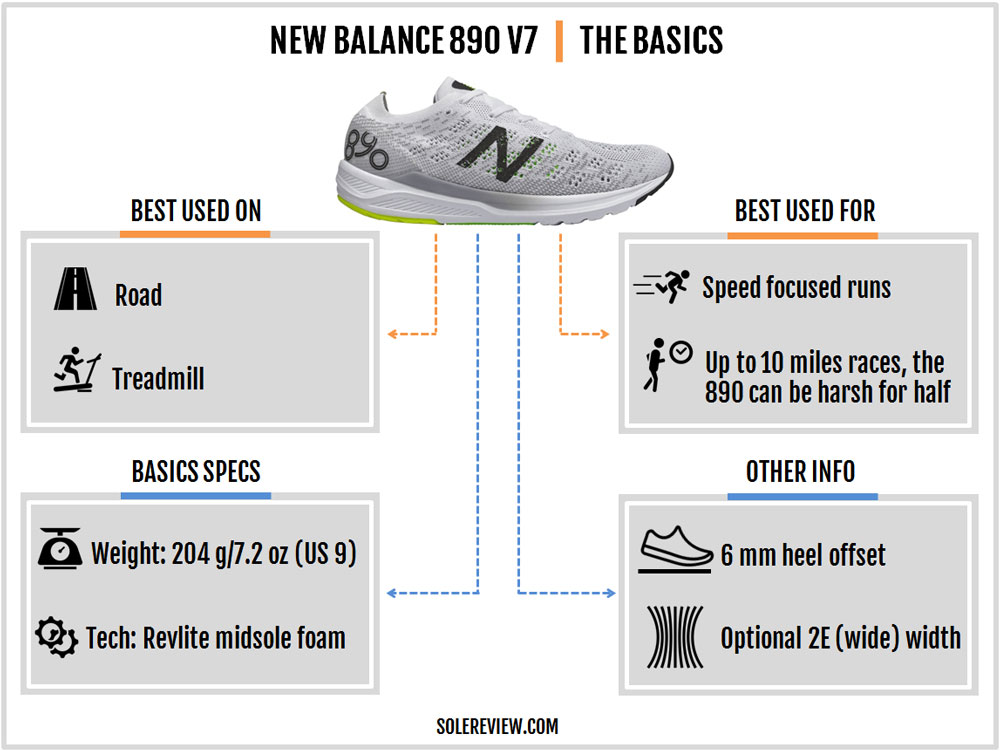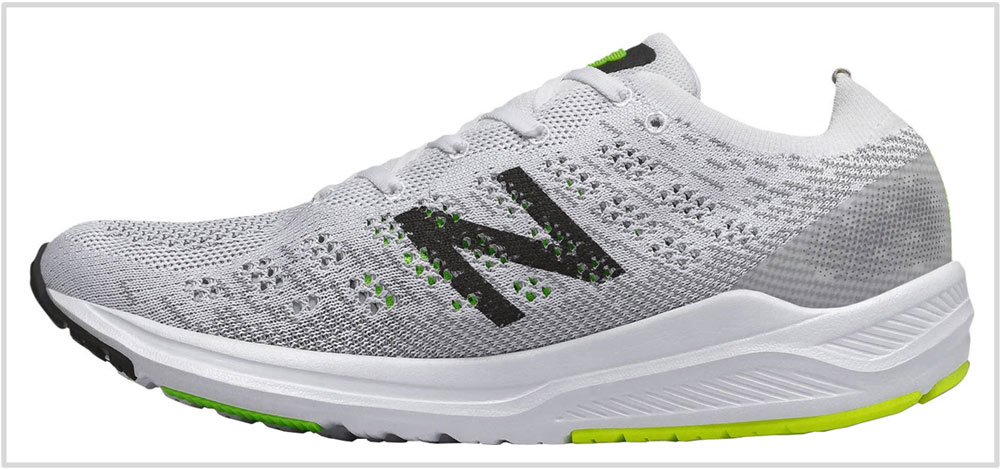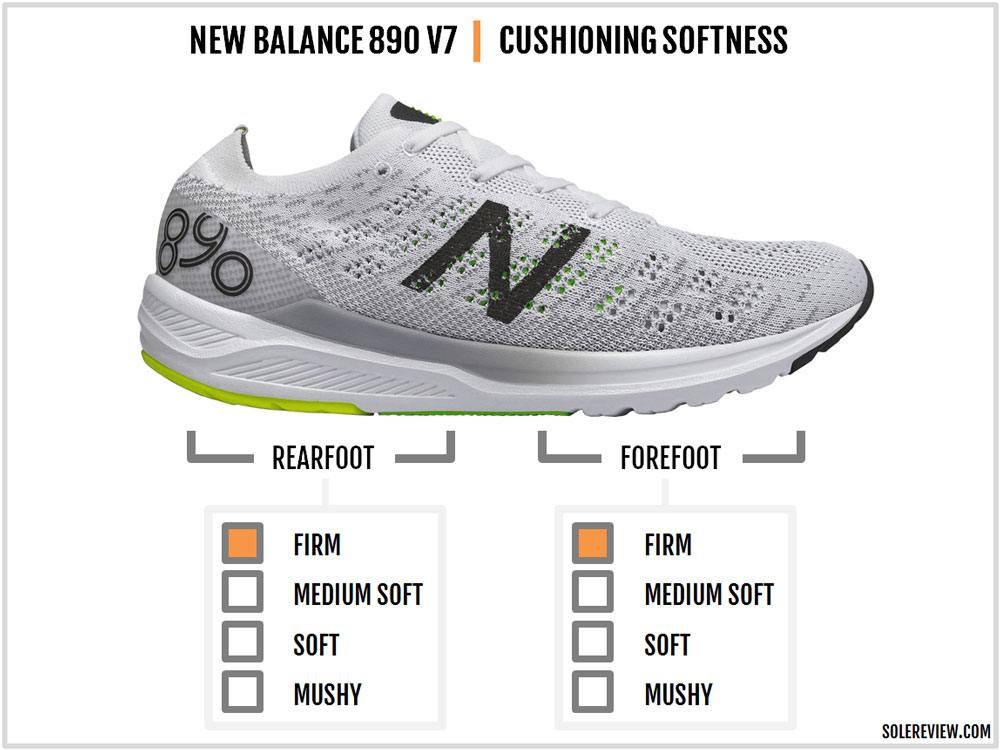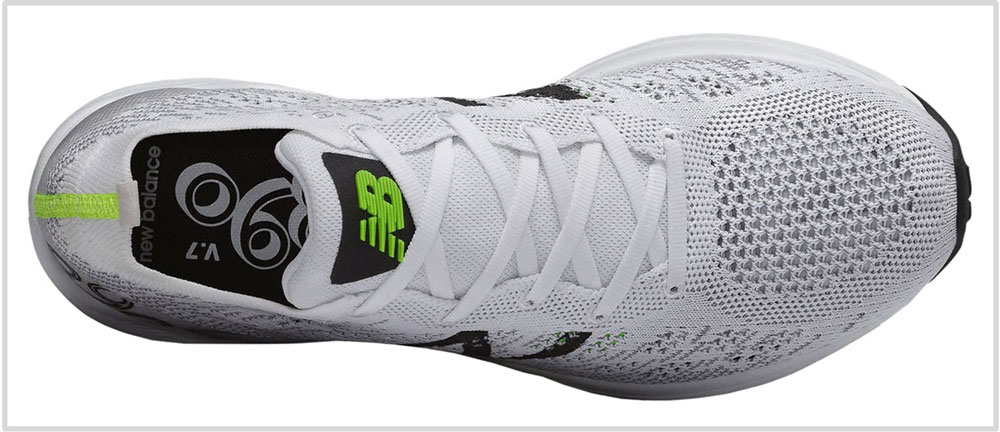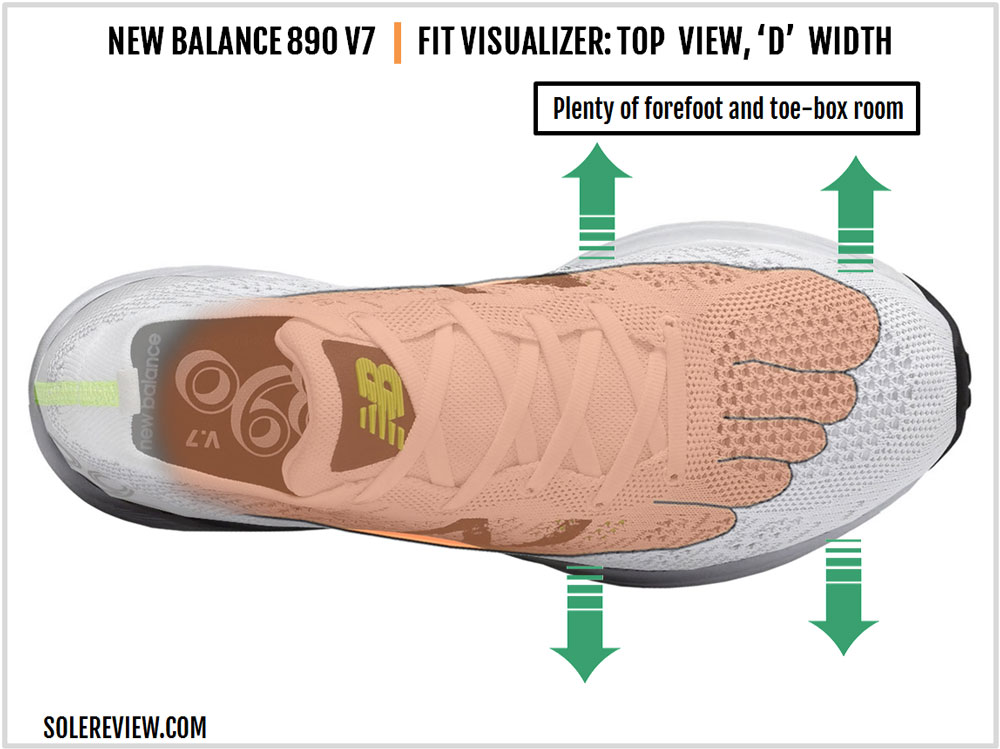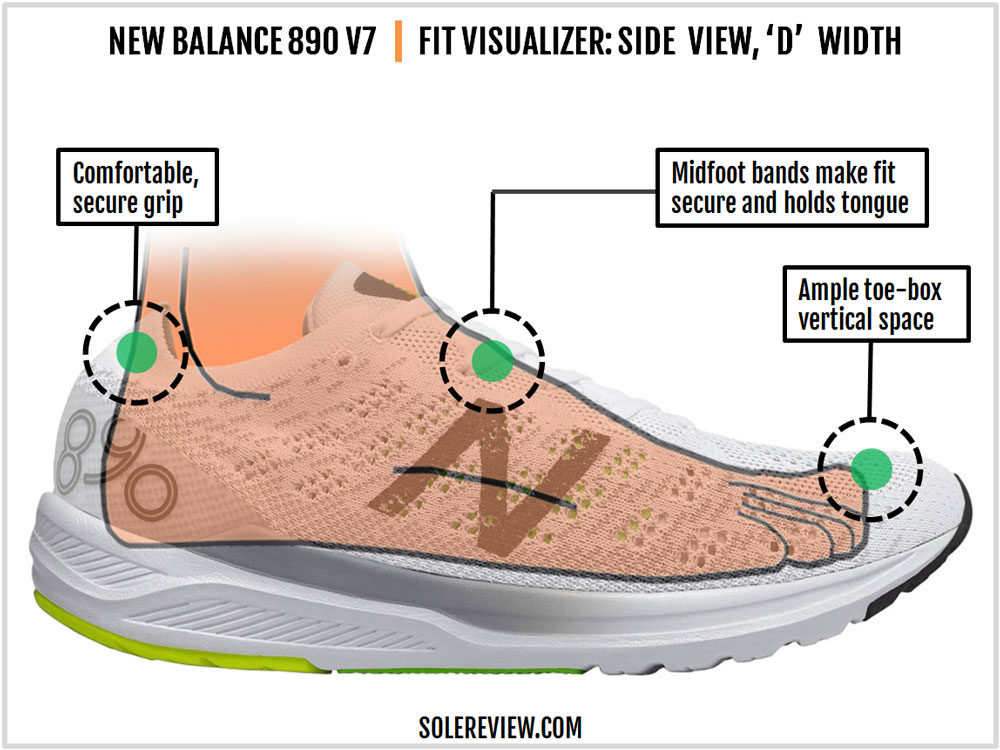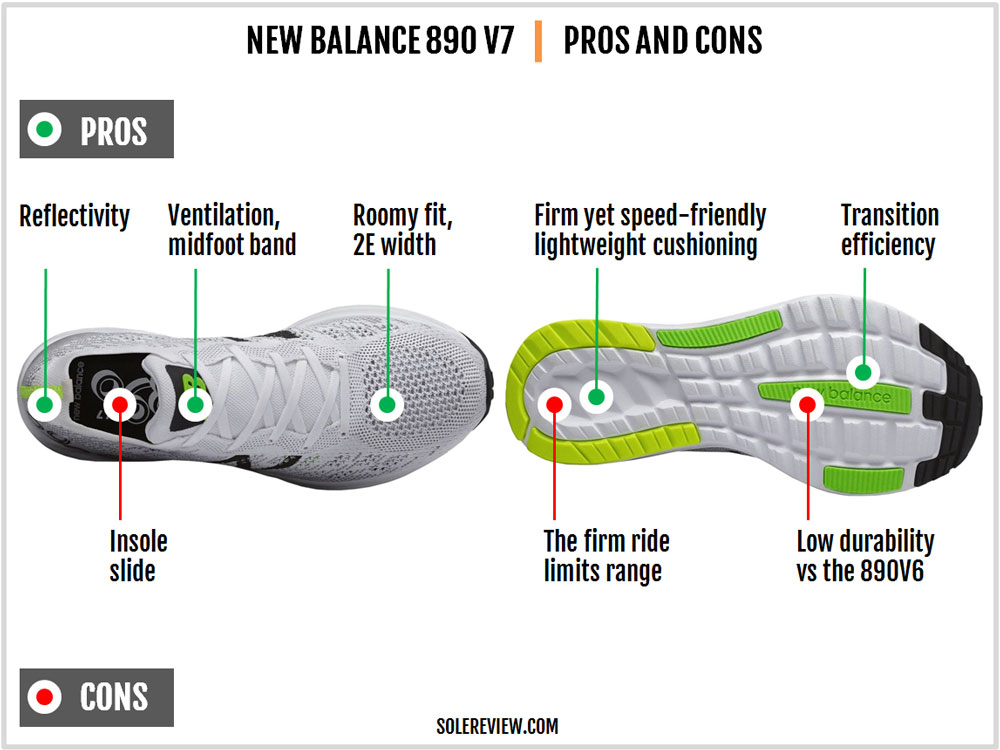INTRODUCTION
There’s a saying in the footwear industry, “shave off two-ounces, and a running shoe is never the same again.”
Alright, nobody ever said that. We just made that up – but you get the point.
The New Balance 890V7 has absolutely nothing in common with the outgoing edition. And when we say nothing, we mean it in every sense of that word.
The V7’s lightweight knit upper has a brand new fit and feel. The midsole is now single-density Revlite foam without the V6’s forefoot TPE strips and outsole rubber.
So rather than an ‘update,’ the 890 has transformed into a completely different shoe which bears no resemblance to the previous model – except for the name, that is. The 890V7 also has a sharper sense of purpose.
Rather than a daily trainer which New Balance advertises it as, the 890’s very stiff ride makes it better suited for specific use-cases. For speed work and treadmill use, the 890V7 is one of our top picks.
At the same time, the traits which give the 890 its newly acquired focus reduces the latter’s versatility. For example, the 890V6 was easier on the foot and better qualified as a daily trainer than the V7.
The moral of the story is: know what you’re buying here. It’s easy to get deceived by the 890’s innocuous foam midsole and inviting knit upper.
No matter what New Balance says, most runners will encounter functional gaps if they rely only on the 890 as their daily trainer. While the 890 deserves its spot in a three-shoe rotation as a firm and lightweight trainer for speedwork, cushioning needs are better served by other New Balance models.
The Fresh Foam Beacon is a lightweight daily trainer which is cushioned yet versatile enough for most run types. The Fresh Foam 1080V9 works better for very long distance runs when comfort becomes a priority. For short races, the Hanzo SV2 is perfect.
Among others, the Nike Epic React V2 is cushioned as much it is lightweight; that combination makes it great for comfortable longer runs. The Saucony Type A8 is a competent road racer, but it’s better to wait for the Type A9 to be released this month.
THE RIDE EXPERIENCE
The 890V7’s very firm ride belies its looks. From the outside, the single-density foam midsole looks inviting in an “oh-must-be-so-soft” kind of a way.
But the Revlite midsole is anything but soft; it actually borders on hard. Initially, we thought that the ride resembled the firmness of the earlier Saucony Kinvaras. But no, the 890 is even firmer. At least those Kinvaras had a Powergrid heel insert and a thick sockliner.
The 890V7 has an insole but it adds only marginal softness due to its thinness. It is somewhat easier to think of the 890 as a thicker version of the 1400V6, but even then, the 1400 is more responsive due to the thicker insole and the rubber outsole. The Vazee Pace had a similar firm midsole but it had a softer top and bottom layer due to the thicker insole and a forefoot outsole made of blown rubber.
The molding method of the midsole also matters here. Models like the 1400 or the discontinued Vazee Pace use compression molded Revlite foam – the 890 has an injection molded midsole. Compression molded midsoles tend to be more resilient, whereas injection molded foam has a flatter feel.
After the first run, one realizes that the 890 has a very specific use-case. It’s hard to run 10+ miles in the 890 without wishing that you had a softer shoe in its place. Sure, at mere 204 grams/7.02 ounces, the build is super lightweight and nimble. The upper is also very roomy and air-circulation friendly. But there’s a hard limit to what the 890 is capable of.
In order to truly enjoy the 890, one needs to draw on its strengths. The firm Revlite midsole has nearly no compression give, unlike relatively softer shoes like the Zante Pursuit.
Contrary to what New Balance claims, the 890 isn’t responsive or bouncy. The ride feels flat when benchmarked against modern running shoe standards. And despite what one might assume, that isn’t a bad thing at all.
A flat midsole accomplishes several things, all of which are useful when you’re running fast. Firstly, there’s almost no difference between the published and loaded heel drop numbers. The 890 behaves like a true 6 mm drop running shoe, unlike products where the dynamic offset depends on the compression of the soft midsole.
The consistent firmness of the 890 makes speed-work distraction free. The forefoot transitions are snappy – though not as much as the 890V6 due to the missing TPE strips – but there’s zero loss in the V7’s efficiency. The rocker shaped midsole with a prominent heel and toe spring also facilitate quick toe-offs.
The level of stability also benefits from the midsole firmness. There is no bias at all; the 890’s sidewalls are also exaggerated to cup the foot in. The firm and stable ride also make the 890 an excellent treadmill running shoe.
New Balance advertises the 890 as a daily trainer but it is far from one. The midsole is firm so there’s not enough comfort for longer distances. The 890 feels at home during faster paces (4:30 km or lower) and that’s what you should use it for.
As we said, there’s no similarity between the 890V6 and V7, the outsole included. Unlike the V6, the new outsole gets rid of the TPE strips under the forefoot. It also makes most of the outsole rubber-free except for high wear zones and transitional sections.
Rubber is arranged in a horseshoe-shape along the fringes of the heel. This is a practical placement, as these strips are exactly where they need to be. The outer midfoot and inner forefoot get useful transitional bands of rubber.
The traction provided by the forefoot strip and Revlite foam is ok; there’s nothing to complain about. Having said that, runners replacing the 890V6 with the V7 will miss the assuring grip of the former’s blown rubber outsole.
With these radical updates, it isn’t surprising that the 890V7 weighs 2-ounces less than the previous model.
The small piece of forefoot rubber is the first to take the brunt of push-offs. Expect the texture to disappear in less than 50 miles – though that’s not something which adversely affects the grip.
The insole is already thin to begin with, so its gradual flattening will hardly be noticed. The firm midsole will hold its structure as long as the rest of the shoe.
If there’s a weak link in the 890’s design, that would be the insole.
Like some of us, the 890’s insole seems to be claustrophobic and only likes it when it’s halfway out through the collar. This was observed on the Beacon too, so this isn’t a once-in-a-shoe oversight.
Looking at the design, one can guess why the slide happens. The internal bands hugging the midfoot originate under the insole, so the insole is partially resting on these stretchy synthetic bands. As you kick the 890 rearwards during push-offs, the bands seem to lift the insole ever so slightly.
Even at a running cadence of 70~80, the bands are tugging on the sides of the insole more than a thousand times – even during a short 5K. This, when combined with the push-off motion, appears to dislodge the insole. Add in some moisture from sweat, and that only speeds up the slide process. Maybe we’re wrong, but this seems like a logical hypothesis.
Pasting the insole to the lasting will definitely eliminate the problem. And for a speed shoe like the 890, a pasted insole should be the norm. Even the Nike Vaporfly 4% has a glued-on sockliner.
UPPER FIT QUALITY
There is a surprising amount of room inside a shoe which is best used as a speed trainer.
Usually, speed trainers are narrow-fitting beasts, if almost a sensory reminder of what you’re supposed to be doing with them. You know, as in, “Narrow upper! firm ride! run fast! No, faster!”
Despite the midsole’s tempo manners, the upper is roomy. The toe-box, in particular, has plenty of splay room, and if that wasn’t enough, there’s also a 2E (wide) option available.
The knit upper isn’t inherently elastic like the Zante Pursuit. The material reminds us of the Nike Free RN Flyknit 2018. The engineered mesh structure – the kind with open areas for ventilation and dense sections for support – has only a small degree of mechanical stretch. The said vents also make the 890 very breathable – this is one of the breeziest shoes of 2019 for sure.
The tongue is held in place by elastic arch bands, hugging the waist of the foot securely yet in comfort. The bands are perforated so the ventilation isn’t negatively affected.
It’s interesting to see a combination of a regular padded tongue with a minimal knit upper. The Zante Pursuit and the Asics DS Trainer 24 features a similar set-up.
A padded tongue filters the top down lacing pressure and adds interior comfort to an otherwise deconstructed design.
Though the 890 doesn’t have a padded collar like the V6, the heel isn’t lacking in grip. The knit band is elastic and snaps reassuringly below the ankles. The insides are backed with a soft material and a minor amount of foam padding.
If you thought that the 890’s seemingly no-frills upper lacked low-visibility, you’d be happily mistaken. The translucent covering on the heel not only houses the ‘890’ text but is also reflective.
The semi-transparent cupping also functions as a heel counter and provides rearfoot support.
PROS AND CONS
As a speed shoe, the New Balance 890V7 gets most things right. Low weight and transition efficiency are key ingredients of a speed trainer, and the 890 doesn’t disappoint. Its very firm ride and 7-ounce weight create a distraction-free running experience.
The 890 goes against the norm and makes the toe-box extremely spacious. Yet, there’s no sense of slippage due to the effective midfoot bands. This space is also accompanied by a very well ventilated upper.
New Balance’s use of the external heel layering as a reflective piece is clever design work.
The insole slide is unfortunate on a shoe which checks most of the right boxes. We called this issue out on the Beacon too, and the 890 also suffers from this.
Also, runners who appreciated the 890V6’s robust outsole will find that the V7’s forefoot is more susceptible to wear and tear.
SIMILAR LIGHTWEIGHT TRAINERS
We realized that no two shoes on this guide are similar – unlike in other comparison charts which feature neutral or support trainers.
The New Balance 890V7 has a roomy interior with a stiff ride – which none of the models shown here have. The snug Mizuno Wave Shadow 2 has a firm ride, and yet the layered midsole has greater ‘give’ than the 890.
We reviewed the New Balance Zante Pursuit earlier this month – that’s another lightweight option with a slightly greater ride comfort. The thin midsole is softer than the 890, and the elastic upper wraps the forefoot in a snugger manner.
The Skechers Razor 3 is great. Its Hyperburst foam midsole offers a lightweight and responsive ride which makes it more versatile than the 890. It may not feel as speed focused as the 890, but then, you can use the Skechers shoe for a wider variety of workouts.
Reebok’s new PEBA based foam makes the Floatride Run Fast a cushioned sub-7-ounce shoe. Along with the adidas adizero adios 4, both deliver a ride which is softer than the 890. For runners who find the 890’s firmness unforgiving, it’s worth trying these models. We prefer the Reebok Run Fast over the adios though.
Though the Nike Zoom Streak 7 is more of a road racer than a trainer, it is still a couple of cushioning rungs above a racing flat. There’s enough low-profile cushioning to make it versatile enough for speed training.
| Do you own this shoe? Improve this review by sharing your insights – submit a review here. |


